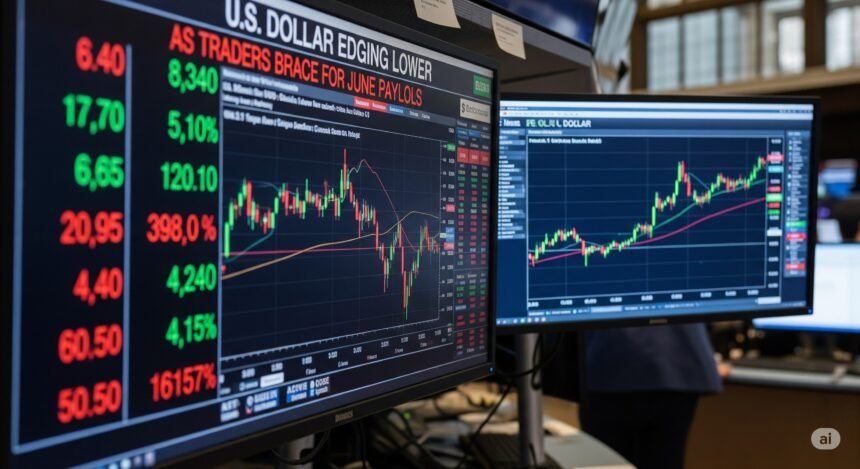Global currency markets were noticeably subdued on Thursday, with the U.S. dollar exhibiting mild weakness ahead of the release of June’s nonfarm payrolls report. Investors have been adjusting their positions in anticipation of fresh labor data that could offer critical signals about the Federal Reserve’s next policy steps—especially amid conflicting signals from recent economic reports and geopolitical trade developments.
Dollar Falters, Awaiting Labor Clues
The U.S. dollar index, which measures the greenback against six major global currencies, was near 96.70, hovering close to its lowest point since February 2022. This softness comes after a 33,000-job drop in ADP private payrolls for June, the first decline in over two years.
That unexpected weak print has raised speculation about the Federal Reserve possibly cutting rates in July, with CME’s FedWatch tool now assigning a 25% probability to such a move up from around 20% earlier in the week.
Still, market watchers caution that mixed indicators such as solid JOLTS job openings are muddying the outlook. Fed Chair Jerome Powell has emphasized a data-dependent approach to policy, warning against hastiness in rate decisions.
Trade Shock from Vietnam Deal
The dollar’s tentative slipping has been further impacted by trade shifts abroad. President Trump’s announcement of a new trade agreement with Vietnam, which implements a 20% tariff on Vietnamese imports and a 40% tariff on trans-shipped goods, has excited markets about the potential for similar deals with India and others ahead of the July 9 tariff deadline.
Market analysts suggest the news could reconfigure global supply chains and fuel optimism but simultaneously signal rising trade tensions, especially if China retaliates.
Sterling Strengthens, Fiscal Fears Fade
Meanwhile, the British pound stabilized after a sharp fall earlier this week, supported by news that UK Prime Minister Keir Starmer has fully backed Finance Minister Rachel Reeves amid concern about a welfare policy reversal. The pound is trading near $1.3647, while the euro remains around $1.1806, skirting close to a September 2021 peak.
What Markets Are Watching
- June Nonfarm Payrolls (NFP)
Finalized employment data from the U.S. Bureau of Labor Statistics is scheduled for Thursday at 8:30 a.m. ET (12:30 GMT), the timing has been shifted due to the July 4 holiday. Economists forecast a gain of 100,000–110,000 jobs, down from 139,000 in May with unemployment expected to tick up slightly to 4.3%.
- Wage Growth & Unemployment Rate
Average hourly earnings, a focus for inflation watchers, are projected to rise approximately 3.9% year-over-year matching May’s rate.
- Federal Reserve Reaction
A weaker than expected report could dampen rate hike bets and lift expectations for a Fed cut. Conversely, a strong outcome may quash those hopes and bolster the dollar.
Impact Across Markets
- FX Markets: A weak payrolls number likely pushes the dollar lower, benefiting the euro, yen, and pound.
- Government Bonds: Weak labor data could lower U.S. Treasury yields, while strong data may propel yields higher.
- Gold & Commodities: Soft payrolls could support gold, which has recently hovered near $3,320–$ 3,360. Oil markets, while affected by unrelated inventory flows, also watch dollar moves for sentiment cues.
A Broader Crossroads: Fed, Fiscal, Trade Policies
The dollar’s direction this week is crucially guided by three converging forces:
- Fed tightening fears vs. easing hopes: With Powell signaling caution and ADP’s weak report, markets are leaning toward a possible July rate cut.
- U.S. fiscal policy risks: A sweeping $3.3 trillion tax-and-spending bill passed in the Senate is heightening fiscal concerns—and weakening the dollar.
- Trade developments: The Vietnam deal has raised hopes of broader trade momentum, while tariffs loom large on the horizon.
Analyst Insight
Charu Chanana, chief investment strategist at Saxo, highlighted the stakes:
“The ADP print has certainly raised the stakes for nonfarm payrolls today. What could earlier have been interpreted as ‘bad news is good news’ may now simply be seen as bad news, especially if recession concerns take hold.”
June jobs growth lands below expectations, and U.S. dollar weakness could persist—potentially encouraging a Fed pivot and supporting risk assets like equities and gold. However, a surprise upside in payrolls could reinvigorate the greenback and delay any rate cut discussions.
As markets await the payrolls release, volatility remains high. With traders grilling over labor data, trade plans, and fiscal policy—all undercut by Powell’s caution—the dollar’s short-term path hinges on the U.S. labor report. Markets will quickly test whether a cooling labor market is confirming expectations of imminent easing or simply another blip in a complex economic backdrop.






